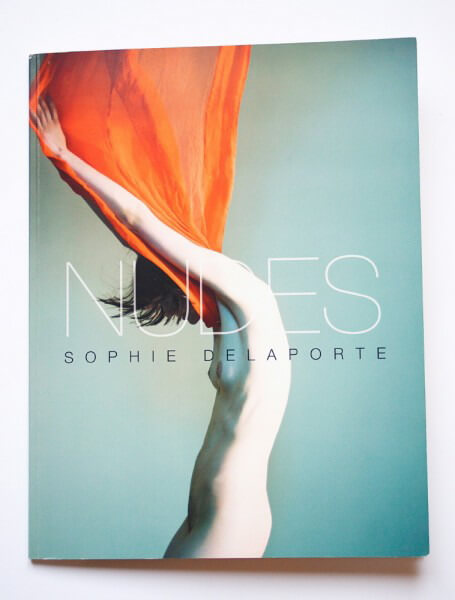Sophie Delaporte is a French photographer who is on permanently good terms with fantasy and a cheerfully offbeat approach. She has a distinctive sense of color, a fabulist’s imagination, an edge of surrealism, and a knack for ambiguous narrative: her models may have hair like aberrant monuments, dance happily with a well-dressed, curlicue-tongued wolf, or stand pensively before a chart of the constellations in an otherwise empty room.
Now her Nudes have inserted a charming and unexpected gambit into the overloaded image world of naked bodies: here are playful photographs of dressed-up undress, a model who fancies going undercover nearly as much as uncovering, and props that share their own lives with her on stage. There’s even a sly edge of humor, which is relatively unfashionable in the nudity game, where titillation or high artistic seriousness crowd the field.
Delaporte sings a body electric: current and quick, seldom static, hardly shocking, charged with energy, and crackling with unpredictable incidents. Seductive in an unlikely fashion, this series of capricious nudes cavorts across an uncommonly witty body of work.
The mostly shapeless fabrics that barely conceal the model’s body here are all couturier clothes masquerading as mere textiles; designers would scarcely recognize them. The photographs suggest that if little girls like to play dress-up, a grown-up girl would really like to play with her clothes, and what’s more, some garments want to return the favor. On occasion, the wayward fashions assert their independence: deciding they’ve had enough, thank you, they teasingly fly off to play all by themselves.
Everything happens in a studio setting that is utterly simple and entirely lush. Color – strong, limited, and bracing — is so bold that it becomes a subject to vie with the one in the title: solid blocks of mossy green and vibrant purple, flurries of orange, pale flesh, black hair.
The series is so charged with motion it might consist of frames from a movie starring Masha Yakovenko, the body in question. A kinetic model, she runs and leaps across the page and flourishes her orange-red cloak like a matador. She pauses occasionally to turn quietly modest, hiding her face behind her hair, and sometimes she’s meditative, coy, or pleased to make couture creations do improbable acrobatics. Most notably, she dances with her clothes rather than putting them on, and she interacts with paper props. An orange construction, a sort of brazenly pop rendition of a Richard Serra Cor-Ten steel sculpture, embraces her; a purple and blue one urges her into positions worthy of Bronzino, that elegant sixteenth-century Mannerist.
Her accompanying designer clothes have been set free of their ordinary duties of making a woman fashionable and alluring in order to go adventuring. Dresses, skirts, and coats — insubstantial partners — are inclined to act without any noticeable assistance from the woman who refuses to wear them. They perform like the wind, whirling and swirling, billowing and flying, quieting down, pretending to be wings, vortices, or clouds, and making shapes for which no analytic equations exist. They’re obstreperous: escaping on an updraft, they uncover the body without so much as an apology. An alternative title for this series series might be “Props having a jolly time
with a nude.” It’s all theater, it’s madcap, it’s dance/drama without a narrative, it’s amusing, it’s intense.
More than a century ago, Loie Fuller, who would influence much modern dance, performed in voluminous floating robes. Though she never revealed her body, she created wild, lovely, momentary forms from the fabrics she stirred into art-nouveau storms. From one angle, Delaporte’s Nudes resemble a naughty update on Fuller. (Well, Fuller would have thought of it that way. Almost nothing but an un-housebroken dog qualifies as naughty any more.)
At times the nude before us covers her face with a bunched-up dress while the parts of the body that are generally concealed remain on conspicuous display. Though this might not be your idea of how to decide if a dress will attract a lover (but it certainly ought to work), it definitely looks like a good time. I’d say it all looks like a good time –for the model, for those wayward clothes, and no doubt for the photographer. Me too.

Sophie Delaporte is a French photographer who is on permanently good terms with fantasy and a cheerfully offbeat approach. She has a distinctive sense of color, a fabulist’s imagination, an edge of surrealism, and a knack for ambiguous narrative: her models may have hair like aberrant monuments, dance happily with a well-dressed, curlicue-tongued wolf, or stand pensively before a chart of the constellations in an otherwise empty room.
Now her Nudes have inserted a charming and unexpected gambit into the overloaded image world of naked bodies: here are playful photographs of dressed-up undress, a model who fancies going undercover nearly as much as uncovering, and props that share their own lives with her on stage. There’s even a sly edge of humor, which is relatively unfashionable in the nudity game, where titillation or high artistic seriousness crowd the field.
Delaporte sings a body electric: current and quick, seldom static, hardly shocking, charged with energy, and crackling with unpredictable incidents. Seductive in an unlikely fashion, this series of capricious nudes cavorts across an uncommonly witty body of work.
The mostly shapeless fabrics that barely conceal the model’s body here are all couturier clothes masquerading as mere textiles; designers would scarcely recognize them. The photographs suggest that if little girls like to play dress-up, a grown-up girl would really like to play with her clothes, and what’s more, some garments want to return the favor. On occasion, the wayward fashions assert their independence: deciding they’ve had enough, thank you, they teasingly fly off to play all by themselves.
Everything happens in a studio setting that is utterly simple and entirely lush. Color – strong, limited, and bracing — is so bold that it becomes a subject to vie with the one in the title: solid blocks of mossy green and vibrant purple, flurries of orange, pale flesh, black hair.
The series is so charged with motion it might consist of frames from a movie starring Masha Yakovenko, the body in question. A kinetic model, she runs and leaps across the page and flourishes her orange-red cloak like a matador. She pauses occasionally to turn quietly modest, hiding her face behind her hair, and sometimes she’s meditative, coy, or pleased to make couture creations do improbable acrobatics. Most notably, she dances with her clothes rather than putting them on, and she interacts with paper props. An orange construction, a sort of brazenly pop rendition of a Richard Serra Cor-Ten steel sculpture, embraces her; a purple and blue one urges her into positions worthy of Bronzino, that elegant sixteenth-century Mannerist.
Her accompanying designer clothes have been set free of their ordinary duties of making a woman fashionable and alluring in order to go adventuring. Dresses, skirts, and coats — insubstantial partners — are inclined to act without any noticeable assistance from the woman who refuses to wear them. They perform like the wind, whirling and swirling, billowing and flying, quieting down, pretending to be wings, vortices, or clouds, and making shapes for which no analytic equations exist. They’re obstreperous: escaping on an updraft, they uncover the body without so much as an apology. An alternative title for this series series might be “Props having a jolly time
with a nude.” It’s all theater, it’s madcap, it’s dance/drama without a narrative, it’s amusing, it’s intense.
More than a century ago, Loie Fuller, who would influence much modern dance, performed in voluminous floating robes. Though she never revealed her body, she created wild, lovely, momentary forms from the fabrics she stirred into art-nouveau storms. From one angle, Delaporte’s Nudes resemble a naughty update on Fuller. (Well, Fuller would have thought of it that way. Almost nothing but an un-housebroken dog qualifies as naughty any more.)
At times the nude before us covers her face with a bunched-up dress while the parts of the body that are generally concealed remain on conspicuous display. Though this might not be your idea of how to decide if a dress will attract a lover (but it certainly ought to work), it definitely looks like a good time. I’d say it all looks like a good time –for the model, for those wayward clothes, and no doubt for the photographer. Me too.


© 2023 Sophie Delaporte. All rights reserved.